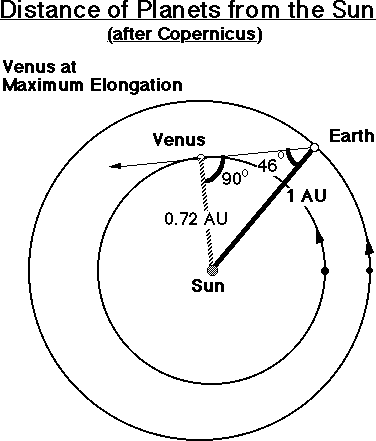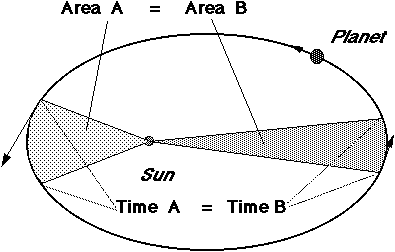
1. Old Ideas -
| Man central | -> Earth in the center of the universe | |
| Heavens perfect and unchangeable | -> motion on perfect circles |
| -> moon, sun, planets, and stars move on consecutive spheres about Earth | |
| Thus the planetary orbits require: | |
| -> complicated model with motion on epicycles to explain the loops |
2. New Ideas -
A) Copernicus (de Revolutionibus 1543)
| Sun in the center; | all planets (incl. Earth) in orbits around the sun | |
| moon around Earth (still everything in perfect circles!) |
| Pro: | Fewer assumptions in the model: | ||
| Natural explanation of retrograde motion of the planets (no epicycles!) | |||
| Natural explanation of Venus, Mercury being always close to the sun | |||
| Larger sun in the center of the motion | |||
| Con: | Throws Earth out of the center (gets opposition by church, non-scientific) |
| Predicts apparent motion of stars due to Earth's motion (Parallax) |
However, not observed at Copernicus' time
| Tycho Brahe: | made the best observations of stars and planets at that time | ||
| but did not see motion of stars | -> scientific argument against orbiting Earth | ||
C) Evidence supporting Copernicus:
a) Galileo (~1610): put things to a test (by using the first telescope for the sky):
| - Sunspots | --> sun rotates, thus Earth might rotate too | ||
| - Jupiter and moons | --> miniature Copernican system | ||
| - Venus' phases | --> can only be explained by Copernicus' model | ||
| - Sun and moon imperfect (sunspots, craters) | --> heaven is not perfect | ||
| b) Supernova | --> things in heaven change | ||
| c) Aparition of comet | --> things in heaven change | ||

D) Model makes new predictions
| - Can calculate sidereal periods of planets | (given the synodic periods) | |||
| - Can calculate relative distances of planets | (using geometry) | |||
| Easy for Mercury and Venus: | ||||
| Sun, planet, Earth | -> rectangular triangle at max. elongation | |||
Criteria for Scientific Models:
| Criteria
for a good Model |
Ptolemy | Aristarch
Copernicus |
Evidence
(+ Galileo) |
| Assumptions a)
b) |
Earth stands still
Objects rotate about the Earth |
Earth rotates
Earth orbits about Sun |
Sun rotates (sunspots)
Jupiter's moons -> mini solar system |
| Scientific: | |||
| 1) explains observations | Ã | Ã | exact positions in sky |
| 2) minimizes assumptions | epicycles
Mercury, Venus orbit about special points |
no additional | retrograde motion
Mercury, Venus always close to Sun |
| 3) new tools | - | relative distances of planets | variing brightness of planets over orbit |
| 4) makes predictions | Stars stand still
Venus never more than 1/2 lit |
Stars go with Earth's
motion (Parallax)
Venus shows all phases as the moon |
Not before 1835!!!
Venus' phases seen with telescope! |
| Non Scientific | |||
| Earth central | Sun (large) central | relative size (E.- S.) | |
| Heaven is perfect | Earth is part of the sun's system, i.e. similar | Supernova
Comet, Sunspots, Craters on Moon |
Abandoned circles on observational evidence using excellent material of Tycho Brahe
Kepler's Laws
| i. | (1609) Planets on Elliptical orbits; | sun @ one focus Þ sun special | ||
| ii. | (1609) Planet-Sun line sweeps equal areas in equal times | |||

Implies that
Explains that
| iii. | (1619) Period - Distance Relation for all the planets |
(average distance in AU)3 = constant * (period in years)2
(Applies also to Jupiter's moons --> laws "universal", different constant)
Implies that
| "Keplerian orbits": | small objects orbiting a large 'central' object | |
| Important characteristic (we will use this later very often!!): | ||
| orbital speeds decrease at greater distances from the central object | ||
a) Sun much further away than moon
was derived from the fact that
| Sun and moon are almost at right angle for half moon | (Aristarch) |
b) Distances of planets
| in units of the Earth - Sun distance | (Copernicus) | ||
| -> if any absolute distance known | -> all distances known | ||
Local comparison with meter stick is needed to get absolute distances.
To measure the universe we start with the size of the Earth
a) Size of the Earth:
| First measurement | (Eratosthenes) | ||||
| - sun under different angle from different locations on Earth | |||||
| - angle and distance of locations | -> circumference of Earth | -> diameter | |||
b) Get any absolute (i.e. km) distance in the solar system:
- distance to moon from lunar eclipse
compare the size of Earth's shadow (= size of the Earth) with size of moon
| -> diameter of moon | ||
| with angular size of moon | -> distance of moon |
- use Earth as a baseline for parallax measurements (from 2 points on Earth)
| Richer and Cassini (1672) | -> derived parallax for Mars | |
| Later transits of planets through the disc of the sun were used | ||
| - modern method: | radar reflections off planets | |
| Measure time between emission and return of radar signal | ||
| with speed of light | -> distance of object | |
c) Planetary sizes
with known distance
| measure angular size of object | -> size of object |